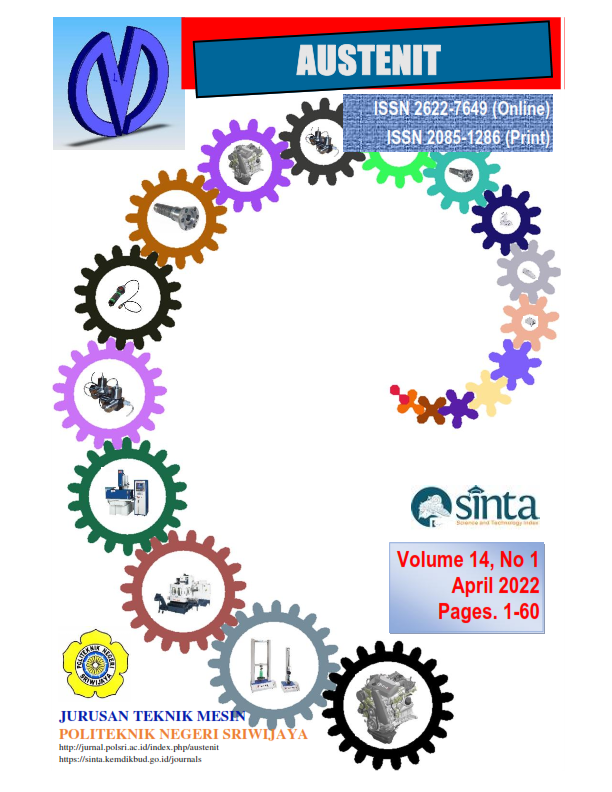STIRLING ENGINE: FROM DESIGN TO APPLICATION INTO PRACTICE AND EDUCATION
DOI:
https://doi.org/10.53893/austenit.v14i1.4601Keywords:
Keywords: Stirling engine; recycled energy; design; education program.Abstract
Stirling motor is a type of outside ignition heat motor that can utilize various fuel sources from customary structures (coal, oil, kindling, rice husk, and so forth) to sustainable power sources (sun-oriented energy), climate, squander heat usage, and so forth). The article centers around introducing the fundamental highlights of the improvement history, activity qualities, and plan techniques for certain sorts of Stirling motors, in this way offering useful appropriateness as well as a college preparing for understudies. The understudy studying Thermal Engineering in our nation today.
Â
Â
Downloads
References
Sternberg, D. C., Pong, C., Filipe, N., Mohan, S., Johnson, S., & Jones-Wilson, L. (2018). Jet Propulsion Laboratory small satellite dynamics testbed simulation: on-orbit performance model validation. Journal of Spacecraft and Rockets, 55(2), 322-334.
Kongtragool, B., & Wongwises, S. (2003). A review of solar-powered Stirling engines and low temperature differential Stirling engines. Renewable and Sustainable energy reviews, 7(2), 131-154.
Soto, G. J., Savransky, D., Garrett, D., & Delacroix, C. (2019). Parameterizing the search space of starshade fuel costs for optimal observation schedules. Journal of Guidance, Control, and Dynamics, 42(12), 2671-2676.
West, C. D. (1988). A historical perspective on Stirling engine performance. In Proceedings of the 23rd intersociety energy conversion engineering conference, Paper (Vol. 889004).
Podesser, E. (1999). Electricity production in rural villages with a biomass Stirling engine. Renewable Energy, 16(1-4), 1049-1052.
Der Minassians, A., & Sanders, S. R. (2011). Stirling engines for distributed low-cost solar-thermal-electric power generation. Journal of solar energy engineering, 133(1).
Menniti, D., Sorrentino, N., Pinnarelli, A., Burgio, A., Brusco, G., & Belli, G. (2014, June). The concentrated solar power system with Stirling technology in a micro-grid: The simulation model. In 2014 International Symposium on Power Electronics, Electrical Drives, Automation and Motion (pp. 253-260). IEEE.
Van Nganh, P., & Tung, H. A. (2016). Stirling engine: from design to application into practice and education. Journal of Technical Education Science, (35B), 44-51.
Bumataria, R. K., & Patel, N. K. (2013). Review of stirling engines for pumping water using solar energy as a source of power. International Journal of Engineering Research and Applications, 3(1), 864-868.
Kerdchang, P., MaungWin, M., Teekasap, S., Hirunlabh, J., Khedari, J., & Zeghmati, B. (2005). Development of a new solar thermal engine system for circulating water for aeration. Solar Energy, 78(4), 518-527.
Ahmed, K. O. D. (2004). Simulation on the Performance of a Stirling Cooler for Use in Solar Powered Refrigerator (Doctoral dissertation, Universiti Putra Malaysia).
Li, Y., Choi, S. S., & Yang, C. (2014, June). An average-value model of kinematic Stirling engine for the study of variable-speed operations of dish-stirling solar-thermal generating system. In 11th IEEE International Conference on Control & Automation (ICCA) (pp. 1310-1315). IEEE.
Ntumba, M., Gore, S., & Awanyo, J. B. (2021). Prediction of Apophis Asteroid Flyby Optimal Trajectories and Data Fusion of Earth-Apophis Mission Launch Windows using Deep Neural Networks. arXiv preprint arXiv:2104.06249.
Ziabasharhagh, M., & Mahmoodi, M. (2012). Analysis and optimization of beta-type Stirling engine taking into account the non-ideal regenerator thermal and hydraulic losses effects. Modares Mechanical Engineering, 12(2), 45-57.
Xiaoan, M. A. O., & Jaworski, A. J. (2010). Oscillatory flow at the end of parallel plate stacks–phenomenological and similarity analysis. Fluid Dynamics Research (Online), 42.
Hooshang, M., Toghyani, S., Kasaeian, A., Moghadam, R. A., & Ahmadi, M. H. (2018). Enhancing and multi-objective optimising of the performance of Stirling engine using third-order thermodynamic analysis. International Journal of Ambient Energy, 39(4), 382-391.
Cheadle, M. J., Nellis, G. F., & Klein, S. A. (2008). Regenerator friction factor and Nusselt number information derived from CFD analysis. Georgia Institute of Technology.
Snyman, H., Harms, T. M., & Strauss, J. M. (2008). Design analysis methods for Stirling engines. Journal of Energy in Southern Africa, 19(3), 4-19.
Senft, J. R., & Engines, R. S. (1993). Oxford University Press: New York. NY, USA.
Walker, G. (1980). Stirling engines.
Walpita, S. H. (1983). Development of the solar receiver for a small Stirling engine. Special study project report no. ET-83-1, 3.
Schmidt, G. (1871). The theory of Lehmann’s Calorimetric Machine, Z. ver. Dtsch. ing, 15.
Walker, G. (1973). Stirling-cycle machines. Oxford University Press.
Stirling, R. (1816). Improvements for Diminishing the Consumption of Fuel and in Particular an Engine Capable of being Applied to the Moving of Machinery on a Principle Entirely New. English Patent 4081.
Downloads
Published
How to Cite
Issue
Section
License
Copyright (c) 2022 Authors and Publisher

This work is licensed under a Creative Commons Attribution-ShareAlike 4.0 International License.
The Authors submitting a manuscript do so on the understanding that if accepted for publication, Authors retain copyright and grant the AUSTENIT right of first publication with the work simultaneously licensed under a Creative Commons Attribution-ShareAlike License that allows others to share the work with an acknowledgment of the work's authorship and initial publication in this journal.
AUSTENIT, the Editors and the Advisory International Editorial Board make every effort to ensure that no wrong or misleading data, opinions or statements be published in the journal. In any way, the contents of the articles and advertisements published in AUSTENIT are the sole responsibility of their respective authors and advertisers.














